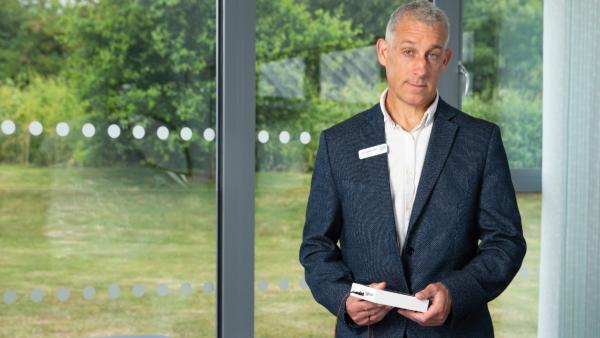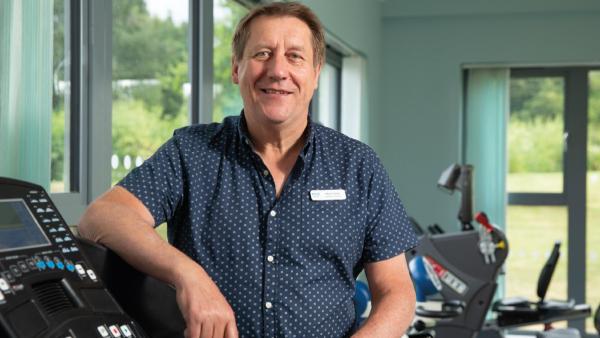Dubbed the ‘first of its kind in the world’ a new Parkinson’s centre for integrated therapy has opened in Kent. Gary Henson reports
One in 37 people live with Parkinson’s, a prevalence that is set to nearly double by 2065, explains David Wilkinson, director of the Parkinson’s Centre for Integrated Therapy and professor of psychology at the University of Kent.
Drug therapies can partly manage the motor symptoms which include tremor, muscle rigidity, freezing of gait and slowness of movement. Other symptoms such as mood disturbance, fatigue, pain, cognitive impairment and bladder and bowel changes are harder to manage. Accordingly, the National Institute for Health and Care Excellence (NICE) point out that the multi-faceted nature of Parkinson’s requires a multi-faceted treatment approach that includes non-pharmacological therapies such as physiotherapy, speech and language therapy, occupational therapy and nutritional guidance.
‘Although not mentioned in the current NICE guidelines, mental health therapy is also considered essential by the Neurological
Alliance and NHS Long Term Plan,’ said David. ‘Unfortunately, access to non-pharmacological therapies is often delayed and difficult to secure on an on-going basis.’
As an example, he refers to the Parkinson’s UK 2019 audit which found that only 39 per cent of local physiotherapy referrals met the standard time from referral to initial assessment, and only 10 per cent of those referred (most of which were routine rather than urgent) had received previous physiotherapy specific for Parkinson’s.
‘Informal feedback from our community neuro-rehabilitation NHS partners tells us that physiotherapy waiting times for those that it does not prioritise (that is, those who are not house-bound or in the later stage of illness) can be as long as 18 months, by which time the patient has de-conditioned and developed additional features in need of management.
‘As a consequence, disability accrues and management becomes reactive rather than proactive, focusing more on medical complications than primary symptoms and prevention. An allied problem is that non-pharmacological therapies are not offered in combination, with clinical services treating each set of symptoms separately even though they interact. This absence of a joined-up service limits clinical outcome and cost effectiveness.’
To address these shortcomings in non-pharmacological therapy, on 11 April - World Parkinson’s Day – a community-based, clinical, research and educational centre was launched, the first of its kind anywhere in the world, said David. The centre, called the Parkinson’s Centre for Integrated Therapy (PCIT), provides comprehensive access to evidence-based, non-drug treatments to improve physical and mental well-being.
The centre is currently owned by the University of Kent and works closely with local NHS partners, charities, other education providers, Canterbury City Council, nearby business and commerce, and people living with Parkinson’s to deliver a connected, community service.
The centre provides a supportive, welcoming environment in which members can devise, run and advertise their own social groups.
Key therapies include neuro-physiotherapy, group exercise, massage, hydrotherapy, psychotherapy, speech and language therapy, nutritional advice, group singing and occupational therapy. The service, David explains, takes a person-centered approach, co-producing personalised care plans that promote self-management, home-based, monitoring, the swift identification of new needs, and liaison with primary and secondary healthcare providers to create a joined-up service. Coupled to this clinical service is the active promotion of social community opportunities for people living with Parkinson’s. The centre, he says, provides a supportive, welcoming environment in which members can devise, run and advertise their own social groups.
‘Separately, educational opportunities are offered to train the next generation of healthcare practitioners and scientists in this integrated approach to non-drug management in Parkinson’s disease.’
At present, placement opportunities for sports science undergraduates to practise massage are offered, and placements for speech and language and occupational therapist trainees are about to be created.
The PCIT also hosts ‘cutting-edge’ research to better understand and treat Parkinson’s, and to support continuous service improvement. The research falls into two main categories explained below.
Vestibular stimulation in the management of Parkinson’s
Non-invasive vestibular stimulation provides a simple and effective means of altering the signals sent from the balance organs of the inner ear to the brain. This alteration can be achieved by applying low-amplitude electric current to the part of the scalp behind the ears (galvanic vestibular stimulation) or by applying warm/cool thermal current to the external ear canal (caloric vestibular stimulation), which likewise changes the firing rates of the nearby vestibular nerve (see Wilkinson, 2021).
These changes modulate metabolic activity and vascular flow in many cortical and subcortical areas of brain, including those involved in the planning and execution of voluntary movement. A long-standing programme of research which David leads has shown the procedure to be of therapeutic value in multiple neurological conditions, including acquired and traumatic brain injury, migraine and, most recently Parkinson’s.
Following a successful single case study that established proof of concept, David designed and led an industry-sponsored randomised, controlled trial designed to show efficacy in 46 volunteers (see Wilkinson et al., 2016, 2019,). Daily, home-based stimulation (20mins, twice per day) for two months showed compelling reductions in motor (including reduced rigidity, freezing and tremor) and non-motor (including better memory, sleep, and less depression and anxiety) features.
These improvements exceeded the minimal clinically important difference, and were accompanied by significant improvement in functional independence and activities of daily living. Effects were present at one month follow-up and still partially visible at six months, indicative of long-term plastic change.
Based on the data, the US Food and Drug Administration subsequently awarded the technique ‘breakthrough status’ for the management of Parkinson’s to facilitate final clearance for in-clinic use.
‘Following positive media coverage, public demand for the experimental treatment has grown,’ David said.
‘In our new centre we are meeting this demand via a programme of experimental study which will focus on dose optimisation and on the benefit brought to other non-drug therapies when vestibular stimulation is applied as an adjunct therapy.’
Exploring the inter-dependencies between non-drug therapies
‘The uncoordinated, singular manner in which different non-drug therapies are administered means that we know little about how much people living with Parkinson’s could benefit when they are administered in an integrated fashion,’ David says.
‘Given the established link between physical and mental health, it is likely that physiotherapy outcomes will be enhanced if a programme of physiotherapy is accompanied by a programme of psychotherapy (and vice-versa); for example, one can imagine that people will be more likely to undertake their home exercises if their depression and anxiety is managed and they feel positively motivated.’
Along similar lines, a programme of speech and language therapy may be more effective if accompanied by attendance at a weekly singing group that also exercises the vocal apparatus. Given the significant increase in cerebral flow induced by vestibular stimulation (which resembles the increases seen during vigorous exercise), it is also possible that priming the brain with a 20-minute session of stimulation prior to mental and physical therapy will increase the likelihood of long-term potentiation and durable gain. By investigating these inter-dependencies, David says they hope to validate a set of ‘rehabilitation prescriptions’ that comprise the best non-drug therapy combinations.
‘By showing that fewer sessions of one particular therapy can in fact be more efficacious if coupled with another, cheaper complimentary therapy performed in the same clinic, we will seek to demonstrate the cost effectiveness of prescribing non-drug therapies together rather than in isolation,’ he explains.
Physio Mark Colley is PCIT clinical lead for the MDT which requires him to assess new patients and triage to the appropriate therapies.
Describing the demand for the service to be ‘incredible’, he said: ‘I’ve assessed well over 100 new members in the 10 weeks the centre has been open and co-formulated a personalised treatment plan (PTP) for each of them. I allow patients to take their time so they can fully explain their Parkinson’s journey and I encourage them to ask questions of all our staff so they are best informed regarding their condition.’
‘I believe that to be truly person-centred, the member should be very much a part of the process and for them to make informed decisions regarding their treatments.
‘Physiotherapy is by far the most requested or referred to therapy. For most patients their PTP consists of three or four different therapies that we feel will improve their condition. With the member’s input we prioritise their treatments and start with those that are most beneficial to them.
'All of our therapists work closely with each other to provide a truly integrated treatment experience for the patient. The feedback we have received from our new patients has been amazing. They have explained that they finally feel listened to, that they are most grateful to have the ability to ask questions, and to feel that they have a real say in their treatment plans.
‘We have created a friendly, welcoming environment for our new members and at the heart of the centre is a volunteer-led social group called Pathways. This already has more than 150 members who are setting up clubs with varied interests such as wine appreciation, touch rugby, walking and painting.
‘All our core therapies are evidence-based and NICE recommended for treating people with Parkinson’s.
But what is unique and so special is the way we deliver these services; our physiotherapists are working side by side with our occupational therapists, speech and language therapists and fitness instructors.
This is not just beneficial for the patients but allows our therapists to learn more about each other’s disciplines and how they can be combined to improve patient outcomes. Through our social group we are able to inform our members of upcoming research projects and to talk to them about what participation involves.
‘I am also excited about the prospect of teaching new allied health care practitioners our integrated model of care, passing on to our ethos and standards to the next generation. We plan to offer hydrotherapy at the centre which will add another comprehensive therapy modality.
‘We also aim to bring in podiatry, acupuncture, dance classes specifically designed for people living with Parkinson’s, massage, reflexology, yoga, pilates and supervised gym use.
‘David, myself and all of our therapists strongly believe we are providing a unique, multi-layered, comprehensive service. We offer evidence-based treatments alongside complementary therapies, social groups, cutting edge research and the serious business of helping people with a complex condition laugh, have fun and develop a more optimistic outlook.’
References
- Wilkinson, D. Caloric and galvanic vestibular stimulation for the treatment of Parkinson’s disease: rationale and prospects. Expert Rev Med Devices 18, 649–655 (2021).
- Wilkinson, D. et al. Caloric vestibular stimulation for the management of motor and non-motor symptoms in Parkinson’s disease. Parkinsonism Relat Disord 65, 261–266 (2019).
- Parkinson’s UK Excellence Network. 2019 UK Parkinson’s Audit. Wilkinson, D., Podlewska, A. & Sakel, M. A durable gain in motor and non-motor symptoms of Parkinson’s disease following repeated caloric vestibular stimulation: a single-case study. NeuroRehabilitation 38, 179–182 (2016).
Number of subscribers: 3




